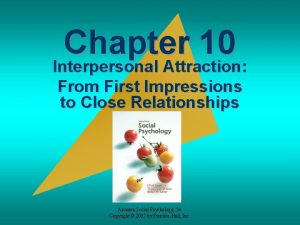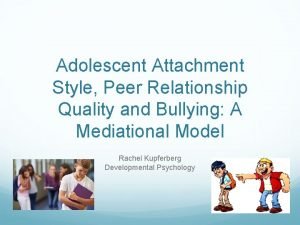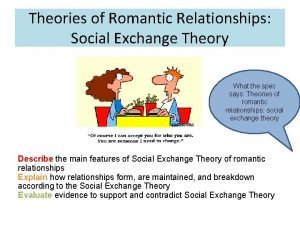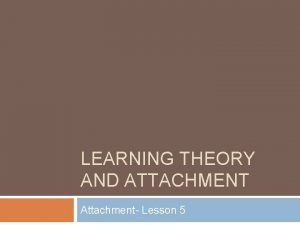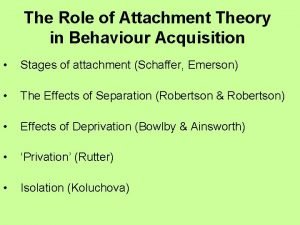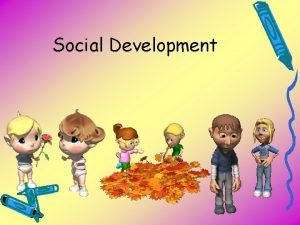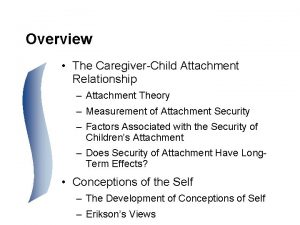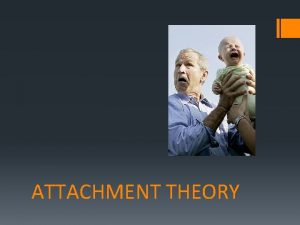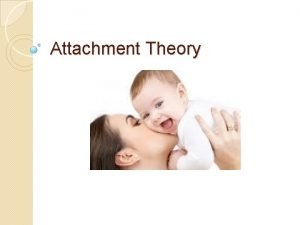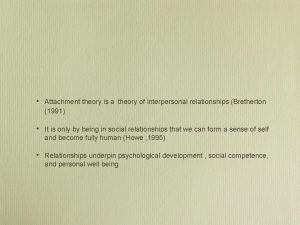Attachment and Social Relationships CHAPTER 14 Attachment Theory









- Slides: 9

Attachment and Social Relationships CHAPTER 14

Attachment Theory • Formulated by Dr. John Bowlby and elaborated on by his colleague Mary Ainsworth. • Theory asked how attachment might have evolved. • Stemmed from psychoanalytic and cognitive theory. • Attachment is a strong affectional tie that binds a person to an intimate companion. • Also a behavioral system through which humans regulate their emotional distress when under threat and achieve security by seeking proximity to another person (scary movie in a theater).

Social Development Parent-Infant Attachment bonds • Stranger Anxiety – the feat of strangers that infants commonly display, beginning by about 8 mths of age. • Attachment – an emotional tie with another person; shown in young children by their seeking closeness to the caregiver and showing distress on separation. • Harlow’s Monkey Experiment: https: //www. youtube. com/watch? v=_O 60 TYAIg. C 4 • Critical Period – an optimal period shortly after birth when an organism’s exposure to certain stimuli or experiences produces proper development. • Imprinting – the process by which certain animals form attachments during a critical period very early in life.

Attachment Differences • Why Children’s attachment difference? • Children in strange situations will normally respond in two ways… Secure attachment - in mother’s presence will play comfortable, happily exploring their new environment. When she leaves they are distressed; when she returns, they seek contact with her. • Insecure attachment – children are less likely to explore their surrounding; they may even cling to their mother. When she leaves, they either cry loudly or remain upset or seem indifferent to her departure or return. • Ainsworth Strange Situation Study: https: //www. youtube. com/watch? v=DRej. V 6 f-Y 3 c • • Regardless of the country, children’s separation anxiety peeks around 13 mths. • Basic Trust – According to Erikson, a sense that the world is predictable and trustworthy; said to be formed during infancy by appropriate experience with responsive caregivers.

Parenting Styles Parents impose rules and expect obedience: “Don’t interrupt. ” “Keep your room clean. ” “Don’t stay out late or you’ll be grounded. ” “Why? Because I said so. ” Parents submit to their children’s desires. They make few demands and use little punishment. Parents are both demanding and responsive. They exert control by setting rules and enforcing them, but they also explain the reasons for rules. And, especially with older children, they encourage open discussion when making the rules and allow exceptions. Authoritarian Permissive Authoritative

Parenting Styles • John Buri and others (1988) reveal that children with the highest selfesteem, self-reliance, and social competence usually have warm, concerned, authoritative parents. • Those with authoritarian parents tend to have less social skill and selfesteem, and those with permissive parents tend to be more aggressive and immature. • Limitations of study? The participants in most studies have been middle-class White families, and some critics suggest that effective parenting may vary by culture. • Yet studies with families of other races and in more than 200 cultures worldwide confirm the social and academic correlates of loving and authoritative parenting. •

The Child • Play become More Social – 6 categories of activity, arranged from least to most social… • • • Unoccupied play- children stand idly, look around, or engage in activities such as pacing. Solitary play – children play alone Onlooker play – watch others play Parallel play – play next to one another, doing much the same thing, but very little interaction. Associative play – interact by swapping material, conversing, or following either other’s lead, but they are not united in the same goal. Cooperative play – join forces to achieve a common goal.

The Adolescent • As with infant, needs a secure base to explore and feel encouragement to explore, and supportive parents help adolescent to become independent and autonomous individuals. • Friendships changes qualitatively with age 1. enjoyment of common activities in early childhood • 2. mutual loyalty and caring in late childhood • 3. intimacy and self-disclosure in adolescence. •

The Adult • Social convoy – a social network and support system that accompanies us during our life’s journey, changing as we go. • Socio-emotional selectivity theory – as a choice older adults make to better meet their emotional needs.

